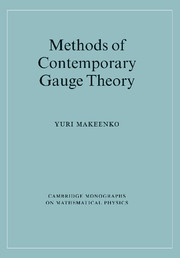Part 2 - Lattice Gauge Theories
Published online by Cambridge University Press: 02 December 2009
Summary
“I never said it.”
“Now you are telling us when you did say it. I'm asking you to tell us when you didn't say it.”
J. HELLER, Catch-22Lattice gauge theories in their modern form were proposed in 1974 by Wilson [Wil74] in connection with the problem of quark confinement in quantum chromodynamics (QCD).
Lattice gauge theories are a nonperturbative regularization of a gauge theory. The lattice formulation is a nontrivial definition of a gauge theory beyond perturbation theory. The problem of nonperturbative quantization of gauge fields is solved in a simple and elegant way on a lattice.
The use of the lattice formulation clarifies an analogy between quantum field theory and statistical mechanics. It offers the possibility of applying nonperturbative methods, such as the strong-coupling expansion or the numerical Monte Carlo method, to quantum chromodynamics and to other gauge theories, which provide evidence for quark confinement.
However, the lattice in QCD is no more than an auxiliary tool in obtaining results for the continuum limit. In order to pass to the continuum, the lattice spacing should be many times smaller than the characteristic scale of the strong interaction.
We shall start this part with a description of the continuum formulation of non-Abelian gauge theories, and will return to this from time to time when discussing the lattice approach. The point is that some ideas, e.g. concerning the possibility of reformulating gauge theories in terms of gauge-invariant variables, which were originally introduced by Wilson [Wil74] on a lattice, are applicable for the continuum theory as well.
Information
- Type
- Chapter
- Information
- Methods of Contemporary Gauge Theory , pp. 83 - 84Publisher: Cambridge University PressPrint publication year: 2002
